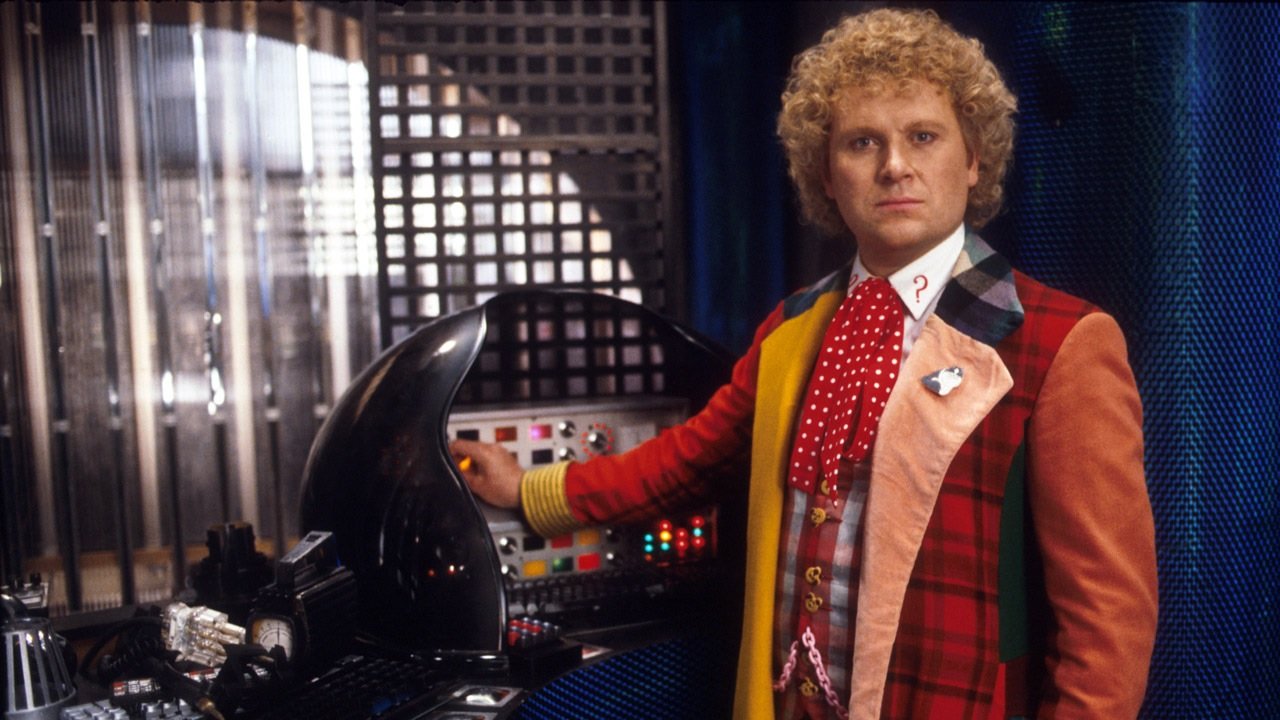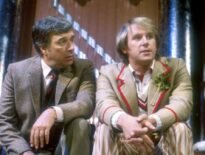On 6th September 1986, Doctor Who returned to BBC1 in a blaze of publicity. There were trailers, newspaper articles, an appearance on Wogan, Colin Baker opening shops around the country, and even a tie-in promotion with Golden Wonder crisps.
Doctor Who was at the heart of BBC1’s new Saturday night line-up between Roland Rat – poached from ITV at great expense – and Noel Edmonds. The first ever episode of Casualty was shown on the same evening. After the infamous 18-month gap, our favourite Time Lord was back. Actually, the gap was 17 months and one week to be precise. This article is about numbers and accuracy. You may want to hide behind the sofa now.
As we all know, the big launch didn’t end well. By the fourth week, only 3.7 million viewers tuned in to see the conclusion of the first segment of The Trial of a Time Lord. Colin Baker was out of a job shortly afterwards and Doctor Who didn’t return to Saturday schedules for nearly 20 years.
One thing has bugged me about the story of the audience collapse of Season 23, and indeed the problems the series suffered until it was cancelled in 1989; the poll positions didn’t make sense.
You may not know what a poll position is, so let me explain. It’s basically like the music charts but for TV shows. The most watched TV show of the week is in the number one spot, the second in number two, and so on.
What confused me was the poll positions for Season 23 and then 24 through to 26. On 6th September 1986, according to every source I have seen, The Trial of a Time Lord Part One had an audience of 4.9 million and a poll position of 69. But Timelash Part Two had an audience of 7.4 million and only hit 79. Mark of the Rani Part One got 6.3 million and was 111th most watched show for the week. You can see the numbers yourself. It didn’t make sense.
A number of explanations have been offered for this statistical anomaly. TV audiences had declined between 1985 and 1986 due to rising competition from new-fangled video recorders, some said. Well, a bit, but not that much. TV audiences are lower in September than they are in winter. Also true, but not by enough and the same pattern shows when The Trial of a Time Lord Part Fourteen gets 5.5 million and 80th place in December 1986.
So, I took myself to the BFI Reuben Library in London. In their comfortable surroundings, anyone can order up the British Audience Research Bureau reports for the years 1986 – 1989. I looked at the very weighty volume including week commencing 6th September 1986. I took my pencil and ran it along the channels for that week (remember there were only four in 1986). I discovered that The Trial of a Time Lord Part One was not the 69th most watched programme that week; it was 112th.

Being the thorough person I am, I worked back. I did the same thing for Revelation of the Daleks Part Two. All the sources showed it had a poll position of 58 and my counting gave me exactly the same number. I tried some more episodes from 1983 through to 1985 and I found no discrepancies in the accepted numbers before 1986. I then tried Battlefield Part One, the lowest-rated episode ever with 3.1 million viewers. All the sources show a poll position of 102. My count showed it in 183rd place for the week. Much lower than thought. I tried a few more episodes, Seasons 23 through 26, and found the same thing, so I calculated them all…
| Episode | Poll Position (believed) | Poll Position (actual) |
| The Trial of a Time Lord Part One | 69 | 112 |
| The Trial of a Time Lord Part Two | 75 | 121 |
| The Trial of a Time Lord Part Three | 98 | 149 |
| The Trial of a Time Lord Part Four | 97 | 147 |
| The Trial of a Time Lord Part Five | 76 | 122 |
| The Trial of a Time Lord Part Six | 87 | 132 |
| The Trial of a Time Lord Part Seven | 87 | 137 |
| The Trial of a Time Lord Part Eight | 84 | 133 |
| The Trial of a Time Lord Part Nine | 85 | 136 |
| The Trial of a Time Lord Part Ten | 93 | 146 |
| The Trial of a Time Lord Part Eleven | 86 | 139 |
| The Trial of a Time Lord Part Twelve | 89 | 148 |
| The Trial of a Time Lord Part Thirteen | 98 | 158 |
| The Trial of a Time Lord Part Fourteen | 80 | 129 |
| Time and the Rani Part One | 71 | 105 |
| Time and the Rani Part Two | 85 | 130 |
| Time and the Rani Part Three | 81 | 126 |
| Time and the Rani Part Four | 86 | 121 |
| Paradise Towers Part One | 88 | 132 |
| Paradise Towers Part Two | 84 | 127 |
| Paradise Towers Part Three | 79 | 125 |
| Paradise Towers Part Four | 93 | 148 |
| Delta and the Bannermen Part One | 90 | 132 |
| Delta and the Bannermen Part Two | 93 | 145 |
| Delta and the Bannermen Part Three | 87 | 138 |
| Dragonfire Part One | 80 | 135 |
| Dragonfire Part Two | 96 | 145 |
| Dragonfire Part Three | 94 | 155 |
| Remembrance of the Daleks Part One | 78 | 128 |
| Remembrance of the Daleks Part Two | 78 | 120 |
| Remembrance of the Daleks Part Three | 91 | 144 |
| Remembrance of the Daleks Part Four | 96 | 147 |
| The Happiness Patrol Part One | 96 | 146 |
| The Happiness Patrol Part Two | 104 | 158 |
| The Happiness Patrol Part Three | 88 | 134 |
| Silver Nemesis Part One | 76 | 125 |
| Silver Nemesis Part Two | 94 | 147 |
| Silver Nemesis Part Three | 98 | 146 |
| The Greatest Show in the Galaxy Part One | 86 | 139 |
| The Greatest Show in the Galaxy Part Two | 99 | 154 |
| The Greatest Show in the Galaxy Part Three | 108 | 151 |
| The Greatest Show in the Galaxy Part Four | 79 | 124 |
| Battlefield Part One | 102 | 183 |
| Battlefield Part Two | 91 | 153 |
| Battlefield Part Three | 95 | 158 |
| Battlefield Part Four | 89 | 148 |
| Ghost Light Part One | 94 | 144 |
| Ghost Light Part Two | 93 | 153 |
| Ghost Light Part Three | 104 | 165 |
| The Curse of Fenric Part One | 104 | 166 |
| The Curse of Fenric Part Two | 104 | 169 |
| The Curse of Fenric Part Three | 104 | 174 |
| The Curse of Fenric Part Four | 104 | 173 |
| Survival Part One | 89 | 138 |
| Survival Part Two | 96 | 150 |
| Survival Part Three | 91 | 146 |
So why the discrepancy between poll positions for episodes before 1986 and those that came later?

Apparently, the source for the ratings information we use today was the Doctor Who production office in the 1980s. The reason for the difference is, someone has used a method of counting that significantly favours the later group of episodes.
Up to Revelation of the Daleks, the poll position is calculated by counting every programme shown in a given week. So, for example, if News at Ten is shown five times in a week, then it occupies five places. If Crossroads is shown three times, then it occupies three places, and so on. From The Trial of a Time Lord, only the show is counted, so News at Ten occupies one place and Crossroads occupies one place. As a result, the poll position for any programme with a rating lower than News at Ten or Crossroads improves.
This matters increasingly the lower your audience is. For Revelation of the Daleks Part Two, with an audience of 7.7 million, the poll position rises from the generally acknowledged 58 to 39 if you count it the second way. For Battlefield Part One, the difference is a whopping 81 places.
The reason it matters more for Battlefield Part One is that, when your programme only gets an audience of 3.1 million, you come in behind pretty much everything — One O’Clock News, early afternoon kids’ shows, late afternoon games: you name it.
So why did this change happen? It’s tempting to picture John Nathan-Turner, perhaps with a small stiffener in hand, faced with the failure of Season 23, coming up with a creative way of casting the figures in a better light. Who can say?


